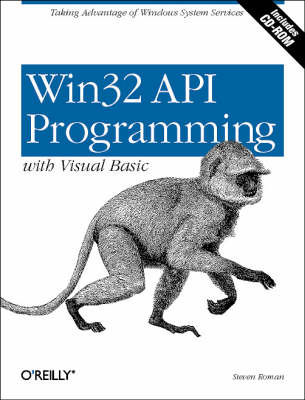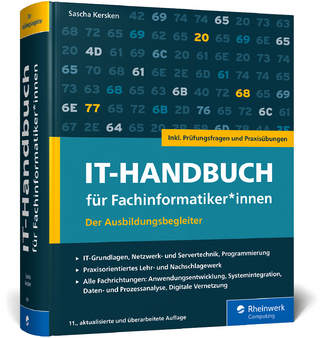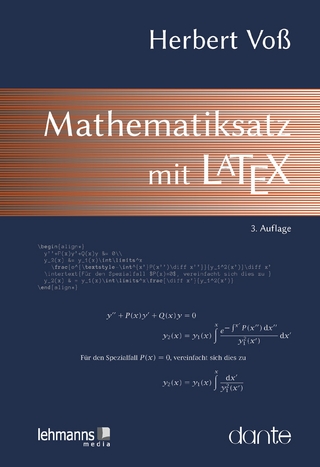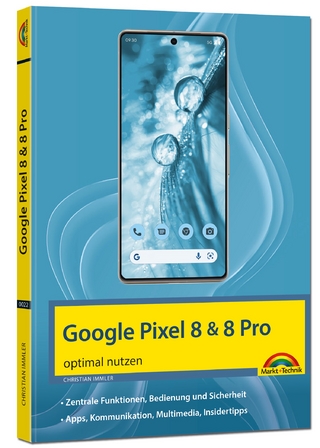
Win32 API Programming with Visual Basic
O'Reilly Media (Verlag)
978-1-56592-631-8 (ISBN)
- Titel z.Zt. nicht lieferbar
- Versandkostenfrei innerhalb Deutschlands
- Auch auf Rechnung
- Verfügbarkeit in der Filiale vor Ort prüfen
- Artikel merken
The Win32 API, or Application Programming Interface, is of immense use in extending the power of Visual Basic. The Win32 API is the collection of functions and subroutines that provides programmatic access to the features of the operating system. It allows Visual Basic programmers far greater access to the inner workings of the Windows operating system without having to suffer through the steep learning curve associated with Visual C++ style Windows programming. The book is designed for users with an intermediate-level (or higher) knowledge of Visual Basic version 4 or later and a desire to stretch VB into the realm of Windows system programming. Users do not need any background in Visual C++, nor do they need any previous experience programming the Win32 API. This book teaches users how to do relatively simple tasks, such as adding tab stops to a list box and gathering system information (i.e., which version of Windows is running on a system and the number of buttons on the user's mouse).
It also teaches users about several advanced programming techniques such as synchronizing two VB applications so they can work in cooperation with each other and how to extract data from controls that belong to another application. Win32 API Programming with Visual Basic also spends a good deal of time describing the basic operations of the Windows NT and Windows 95/98 operating systems. Microsoft's documentation seldom takes into account what the reader knows or does not know. Hence, a solid grounding in the basics of the Windows operating systems will help VB programmers to better understand Microsoft's documentation. This book helps VB programmers eliminate the trial and error process that is usually associated with calling the Win32 API from Visual Basic and does so in a practical, straightforward fashion that is the hallmark of author Steve Roman's style.
Steven Roman is a Professor Emeritus of mathematics at the California State University, Fullerton. He has taught at a number of other universities, including the Massachusetts Institute of Technology, the University of California at Santa Barbara, and the University of South Florida. Dr. Roman received his B.A. degree from the University of California at Los Angeles and his Ph.D. from the University of Washington. Dr. Roman has authored 32 books, including a number of books on mathematics, such as Coding and Information Theory, Advanced Linear Algebra, and Field Theory, published by Springer-Verlag. He has also written a series of 15 small books entitled Modules in Mathematics, designed for the general college-level liberal arts student. Besides his books for O?Reilly (Access Database Design and Programming, Writing Word Macros, Writing Excel Macros, and Developing Visual Basic Add-Ins ) , Dr. Roman has written two other computer books, entitled Concepts of Object-Oriented Programming with Visual Basic and Understanding Personal Computer Hardware, an in-depth look at how PC hardware works, both published by Springer-Verlag. Dr. Roman is interested in combinatorics, algebra, and computer science.
Preface I. Declaring API Functions in Visual Basic 1. Introduction What Is the Win32 API? The Obstacles to Win32 API Programming Under Visual Basic Proceed with Circumspection Cautions 2. Preliminaries Character Codes Parameters and Arguments Dynamic Link Libraries Some C++ Syntax Pointers 3. API Declarations The VB Declare Statement The VC-to-VB Translation Game Plan Passing Parameters to an External Function CopyMemory-A VB Hacker's Dream Dealing with API Errors 4. Data Types What Is a Data Type? Fundamental and Derived Data Types Visual Basic Data Types Basic VC++ Data Types Translating Derived Data Types Win32 Typedefs An Example Structures and User-Defined Types Flags Symbolic Constants 5. Signed and Unsigned Data Types Signed and Unsigned Representations Why Two Different Representations? Unsigned Representation Signed Representation Translating Between Signed and Unsigned Representations Converting Between Word Lengths 6. Strings The BSTR C-Style LPSTR and LPWSTR Strings String Terminology Tools for Exploring Strings String Conversion by VB Passing Strings to the Win32 API Strings and Byte Arrays Getting the Address of a Variable of User -Defined Type 7. System Information Functions The Computer's Name Special Windows Paths The Operating System Version System Metrics System Parameters System Colors 8. Exception Handling Thwarting the General Protection Fault Replacing the Default Exception Handler The Replacement Exception Handler A Complete Example II. The Windows Operating System 9. Windows Architecture Processes and Threads Windows Architecture Differences Between Windows 9x and Windows NT 10. Objects and Their Handles Handles Example: File Mapping 11. Processes Process Handles and IDs Module Handles Identifying a Process Process Pseudohandles Enumerating Processes Is This Application Already Running? 12. Threads Thread Handles and Thread IDs Thread Priority Thread Synchronization Waiting Can Be Tricky 13. Windows Memory Architecture Types of Memory The Address Space of a Process Example: Using GetSystemInfo Allocating Virtual Memory Example: Using GlobalMemoryStatus Virtual Memory Management Heaps of Memory Example: Mapping Virtual Memory 14. Portable Executable Files Module Relocation The PE File Format Example: Getting PE File Information III. Windows (USER32.DLL Programming ) 15. Windows: The Basics Terminology Window Styles Owned Windows Z Order Enumerating Windows Size and Position Functions 16. Windows Messages The Message Queues of a Thread The Windows Messaging System Posting and Sending Messages Example: Sending Messages to a Listbox Interprocess Marshalling Copying Data Between Processes The Local Input State 17. Window Classes and the Window Creation Process Window Classes Predefined Window Classes The Window Procedure of a Window Class Creating a Window Window Styles Windows and VB Controls Example: Spying on Windows 18. Windows Subclassing Subclassing a Window or Window Class Example: Subclassing the VB Checkbox Class 19. Windows Hooks Global and Thread-Specific Hooks Setting the Hook Hook Procedures Hook Types Hook Chains Example: A Local Hook Example: A Global Hook 20. DLL Injection and Foreign Process Access Accessing a Foreign Process: The Hooked Thread Graph Allocating Foreign Memory Example: Foreign Control Extraction Example: Fixing the VB6 Help System IV. The Windows GDI (GDI32.DLL Programming ) 21. Bitmaps Rectangles Bitmaps Bitmap Functions Using Bitmaps in Menus 22. Device Contexts I: Overview How Windows Handles Window Painting Device Contexts 23. Device Contexts II: Types of Device Contexts Information Device Contexts Memory Device Contexts Printer Device Contexts Display Device Contexts Coordinate Systems 24. Device Contexts III: Coordinate Systems GDI Coordinate Systems Virtual Space Device Space Page Space Virtual Space to Physical Space Setting Up Logical Coordinates in Physical Space Mapping Modes World Space 25. Fonts Font Families Font Technologies Character Sets Logical and Physical Fonts Enumerating Fonts V. Appendixes A. The Clipboard B. The Windows Shell C. The Registry and Private Profiles
| Erscheint lt. Verlag | 28.12.1999 |
|---|---|
| Zusatzinfo | illustrations |
| Verlagsort | Sebastopol |
| Sprache | englisch |
| Maße | 153 x 232 mm |
| Gewicht | 870 g |
| Einbandart | kartoniert |
| Themenwelt | Mathematik / Informatik ► Informatik ► Betriebssysteme / Server |
| Mathematik / Informatik ► Informatik ► Programmiersprachen / -werkzeuge | |
| ISBN-10 | 1-56592-631-5 / 1565926315 |
| ISBN-13 | 978-1-56592-631-8 / 9781565926318 |
| Zustand | Neuware |
| Haben Sie eine Frage zum Produkt? |
aus dem Bereich


